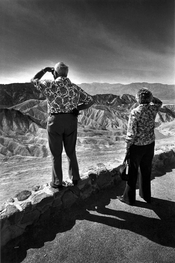logan2z
Subscriber
The Magnum darkroom print guides have been discussed before, but every time I look at one I feel guilty - aside from a bit of dodging and burning here and there, I don't do anywhere near this level of manipulation when making prints. And sometimes I'm even happy with a straight print!
I don't think I'm being lazy. I spend a lot of time attempting to make a print that reflects what I saw/felt when making the photograph - getting the exposure and contrast just right (to my eye). I'll wait for dry-down and make any necessary adjustments once I see the dried/flattened print, etc. So it can take me more than a single print session to come up with a print that I'm happy with. But if my exposure was good and my negative developed properly, it's rare for me to feel the need for significant manipulation.
I keep wondering if I would have gone to this much trouble given the eventual differences between the straight (left) and final (right) Eve Arnold prints made by Magnum's master printer. Maybe I would have made a few of these tweaks, but only a few:


This whole subject came back to mind yesterday when reading an Instagram post from a photographer named Kit Young who said it took him "many weeks" to complete one of his prints. I personally think I would have preferred something closer to the straight print, rather than the highly manipulated and, to my mind, very artificial looking final print:

It's obviously all subjective and it's up to the individual artist to make his own choices, but I can't help but feel I'm not doing 'enough' while making prints when I see the lengths to which others go.
Curious to hear what others think...
I don't think I'm being lazy. I spend a lot of time attempting to make a print that reflects what I saw/felt when making the photograph - getting the exposure and contrast just right (to my eye). I'll wait for dry-down and make any necessary adjustments once I see the dried/flattened print, etc. So it can take me more than a single print session to come up with a print that I'm happy with. But if my exposure was good and my negative developed properly, it's rare for me to feel the need for significant manipulation.
I keep wondering if I would have gone to this much trouble given the eventual differences between the straight (left) and final (right) Eve Arnold prints made by Magnum's master printer. Maybe I would have made a few of these tweaks, but only a few:


This whole subject came back to mind yesterday when reading an Instagram post from a photographer named Kit Young who said it took him "many weeks" to complete one of his prints. I personally think I would have preferred something closer to the straight print, rather than the highly manipulated and, to my mind, very artificial looking final print:

It's obviously all subjective and it's up to the individual artist to make his own choices, but I can't help but feel I'm not doing 'enough' while making prints when I see the lengths to which others go.
Curious to hear what others think...















 .
.